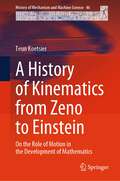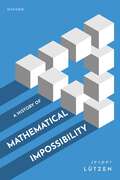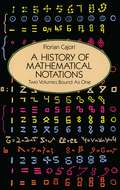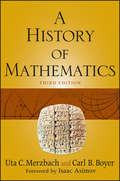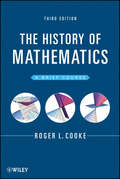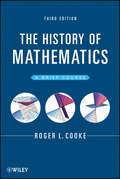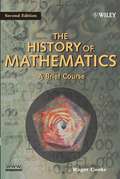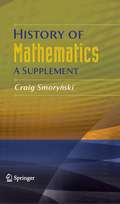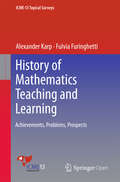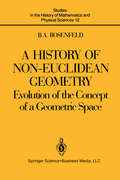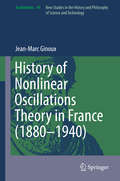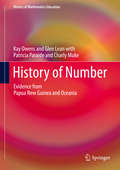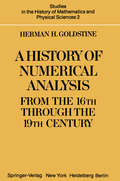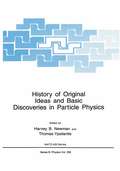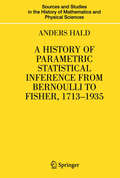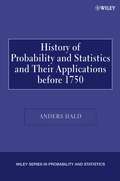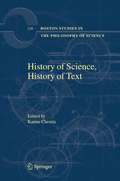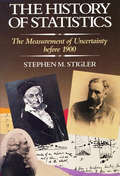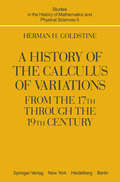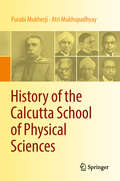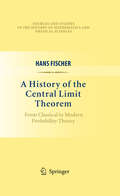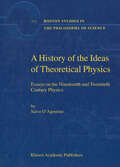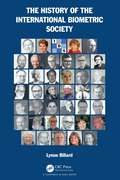- Table View
- List View
A History of Kinematics from Zeno to Einstein: On the Role of Motion in the Development of Mathematics (History of Mechanism and Machine Science #46)
by Teun KoetsierThis book covers the history of kinematics from the Greeks to the 20th century. It shows that the subject has its roots in geometry, mechanics and mechanical engineering and how it became in the 19th century a coherent field of research, for which Ampère coined the name kinematics. The story starts with the important Greek tradition of solving construction problems by means of kinematically defined curves and the use of kinematical models in Greek astronomy. As a result in 17th century mathematics motion played a crucial role as well, and the book pays ample attention to it. It is also discussed how the concept of instantaneous velocity, unknown to the Greeks, etc was introduced in the late Middle Ages and how in the 18th century, when classical mechanics was formed, kinematical theorems concerning the distribution of velocity in a solid body moving in space were proved. The book shows that in the 19th century, against the background of the industrial revolution, the theory of machines and thus the kinematics of mechanisms received a great deal of attention. In the final analysis, this led to the birth of the discipline.
A History of Mathematical Impossibility
by Jesper LützenMany of the most famous results in mathematics are impossibility theorems stating that something cannot be done. Good examples include the quadrature of the circle by ruler and compass, the solution of the quintic equation by radicals, Fermat's last theorem, and the impossibility of proving the parallel postulate from the other axioms of Euclidean geometry. This book tells the history of these and many other impossibility theorems starting with the ancient Greek proof of the incommensurability of the side and the diagonal in a square. Lützen argues that the role of impossibility results have changed over time. At first, they were considered rather unimportant meta-statements concerning mathematics but gradually they obtained the role of important proper mathematical results that can and should be proved. While mathematical impossibility proofs are more rigorous than impossibility arguments in other areas of life, mathematicians have employed great ingenuity to circumvent impossibilities by changing the rules of the game. For example, complex numbers were invented in order to make impossible equations solvable. In this way, impossibilities have been a strong creative force in the development of mathematics, mathematical physics, and social science.
A History of Mathematical Impossibility
by Jesper LützenMany of the most famous results in mathematics are impossibility theorems stating that something cannot be done. Good examples include the quadrature of the circle by ruler and compass, the solution of the quintic equation by radicals, Fermat's last theorem, and the impossibility of proving the parallel postulate from the other axioms of Euclidean geometry. This book tells the history of these and many other impossibility theorems starting with the ancient Greek proof of the incommensurability of the side and the diagonal in a square. Lützen argues that the role of impossibility results have changed over time. At first, they were considered rather unimportant meta-statements concerning mathematics but gradually they obtained the role of important proper mathematical results that can and should be proved. While mathematical impossibility proofs are more rigorous than impossibility arguments in other areas of life, mathematicians have employed great ingenuity to circumvent impossibilities by changing the rules of the game. For example, complex numbers were invented in order to make impossible equations solvable. In this way, impossibilities have been a strong creative force in the development of mathematics, mathematical physics, and social science.
A History of Mathematical Notations: Two Volumes Bound as One
by Florian CajoriThis classic study notes the first appearance of a mathematical symbol and its origin, the competition it encountered, its spread among writers in different countries, its rise to popularity, its eventual decline or ultimate survival. The author's coverage of obsolete notations -- and what we can learn from them -- is as comprehensive as those which have survived and still enjoy favor. Originally published in 1929 in a two-volume edition, this monumental work is presented here in one volume.
A History of Mathematics
by Carl B. Boyer Uta C. MerzbachThe updated new edition of the classic and comprehensive guide to the history of mathematics For more than forty years, A History of Mathematics has been the reference of choice for those looking to learn about the fascinating history of humankind’s relationship with numbers, shapes, and patterns. This revised edition features up-to-date coverage of topics such as Fermat’s Last Theorem and the Poincaré Conjecture, in addition to recent advances in areas such as finite group theory and computer-aided proofs. Distills thousands of years of mathematics into a single, approachable volume Covers mathematical discoveries, concepts, and thinkers, from Ancient Egypt to the present Includes up-to-date references and an extensive chronological table of mathematical and general historical developments. Whether you're interested in the age of Plato and Aristotle or Poincaré and Hilbert, whether you want to know more about the Pythagorean theorem or the golden mean, A History of Mathematics is an essential reference that will help you explore the incredible history of mathematics and the men and women who created it.
A History of Mathematics (History Of Mathematics Ser. #Vol. 2)
by Carl B. Boyer Uta C. MerzbachThe updated new edition of the classic and comprehensive guide to the history of mathematics For more than forty years, A History of Mathematics has been the reference of choice for those looking to learn about the fascinating history of humankind’s relationship with numbers, shapes, and patterns. This revised edition features up-to-date coverage of topics such as Fermat’s Last Theorem and the Poincaré Conjecture, in addition to recent advances in areas such as finite group theory and computer-aided proofs. Distills thousands of years of mathematics into a single, approachable volume Covers mathematical discoveries, concepts, and thinkers, from Ancient Egypt to the present Includes up-to-date references and an extensive chronological table of mathematical and general historical developments. Whether you're interested in the age of Plato and Aristotle or Poincaré and Hilbert, whether you want to know more about the Pythagorean theorem or the golden mean, A History of Mathematics is an essential reference that will help you explore the incredible history of mathematics and the men and women who created it.
The History of Mathematics: A Brief Course
by Roger L. CookePraise for the Second Edition "An amazing assemblage of worldwide contributions in mathematics and, in addition to use as a course book, a valuable resource . . . essential." —CHOICE This Third Edition of The History of Mathematics examines the elementary arithmetic, geometry, and algebra of numerous cultures, tracing their usage from Mesopotamia, Egypt, Greece, India, China, and Japan all the way to Europe during the Medieval and Renaissance periods where calculus was developed. Aimed primarily at undergraduate students studying the history of mathematics for science, engineering, and secondary education, the book focuses on three main ideas: the facts of who, what, when, and where major advances in mathematics took place; the type of mathematics involved at the time; and the integration of this information into a coherent picture of the development of mathematics. In addition, the book features carefully designed problems that guide readers to a fuller understanding of the relevant mathematics and its social and historical context. Chapter-end exercises, numerous photographs, and a listing of related websites are also included for readers who wish to pursue a specialized topic in more depth. Additional features of The History of Mathematics, Third Edition include: Material arranged in a chronological and cultural context Specific parts of the history of mathematics presented as individual lessons New and revised exercises ranging between technical, factual, and integrative Individual PowerPoint presentations for each chapter and a bank of homework and test questions (in addition to the exercises in the book) An emphasis on geography, culture, and mathematics In addition to being an ideal coursebook for undergraduate students, the book also serves as a fascinating reference for mathematically inclined individuals who are interested in learning about the history of mathematics.
The History of Mathematics: A Brief Course
by Roger L. CookePraise for the Second Edition "An amazing assemblage of worldwide contributions in mathematics and, in addition to use as a course book, a valuable resource . . . essential." —CHOICE This Third Edition of The History of Mathematics examines the elementary arithmetic, geometry, and algebra of numerous cultures, tracing their usage from Mesopotamia, Egypt, Greece, India, China, and Japan all the way to Europe during the Medieval and Renaissance periods where calculus was developed. Aimed primarily at undergraduate students studying the history of mathematics for science, engineering, and secondary education, the book focuses on three main ideas: the facts of who, what, when, and where major advances in mathematics took place; the type of mathematics involved at the time; and the integration of this information into a coherent picture of the development of mathematics. In addition, the book features carefully designed problems that guide readers to a fuller understanding of the relevant mathematics and its social and historical context. Chapter-end exercises, numerous photographs, and a listing of related websites are also included for readers who wish to pursue a specialized topic in more depth. Additional features of The History of Mathematics, Third Edition include: Material arranged in a chronological and cultural context Specific parts of the history of mathematics presented as individual lessons New and revised exercises ranging between technical, factual, and integrative Individual PowerPoint presentations for each chapter and a bank of homework and test questions (in addition to the exercises in the book) An emphasis on geography, culture, and mathematics In addition to being an ideal coursebook for undergraduate students, the book also serves as a fascinating reference for mathematically inclined individuals who are interested in learning about the history of mathematics.
The History of Mathematics: A Brief Course
by Roger L. CookeThis new edition brings the fascinating and intriguing history of mathematics to life The Second Edition of this internationally acclaimed text has been thoroughly revised, updated, and reorganized to give readers a fresh perspective on the evolution of mathematics. Written by one of the world's leading experts on the history of mathematics, the book details the key historical developments in the field, providing an understanding and appreciation of how mathematics influences today's science, art, music, literature, and society. In the first edition, each chapter was devoted to a single culture. This Second Edition is organized by subject matter: a general survey of mathematics in many cultures, arithmetic, geometry, algebra, analysis, and mathematical inference. This new organization enables students to focus on one complete topic and, at the same time, compare how different cultures approached each topic. Many new photographs and diagrams have been added to this edition to enhance the presentation. The text is divided into seven parts: The World of Mathematics and the Mathematics of the World, including the origin and prehistory of mathematics, cultural surveys, and women mathematicians Numbers, including counting, calculation, ancient number theory, and numbers and number theory in modern mathematics Color Plates, illustrating the impact of mathematics on civilizations from Egypt to Japan to Mexico to modern Europe Space, including measurement, Euclidean geometry, post-Euclidean geometry, and modern geometrics Algebra, including problems leading to algebra, equations and methods, and modern algebra Analysis, including the calculus, real, and complex analysis Mathematical Inference, including probability and statistics, and logic and set theory As readers progress through the text, they learn about the evolution of each topic, how different cultures devised their own solutions, and how these solutions enabled the cultures to develop and progress. In addition, readers will meet some of the greatest mathematicians of the ages, who helped lay the groundwork for today's science and technology. The book's lively approach makes it appropriate for anyone interested in learning how the field of mathematics came to be what it is today. It can also serve as a textbook for undergraduate or graduate-level courses. An Instructor's Manual presenting detailed solutions to all the problems in the book is available upon request from the Wiley editorial department.
History of Mathematics: A Supplement
by Craig SmorynskiGeneral textbooks, attempting to cover three thousand or so years of mathematical history, must necessarily oversimplify just about everything, the practice of which can scarcely promote a critical approach to the subject. To counter this, History of Mathematics offers deeper coverage of key select topics, providing students with material that could encourage more critical thinking. It also includes the proofs of important results which are typically neglected in the modern history of mathematics curriculum.
History of Mathematics Teaching and Learning: Achievements, Problems, Prospects (ICME-13 Topical Surveys)
by Alexander Karp Fulvia FuringhettiThis work examines the main directions of research conducted on the history of mathematics education. It devotes substantial attention to research methodologies and the connections between this field and other scholarly fields. The results of a survey about academic literature on this subject are accompanied by a discussion of what has yet to be done and problems that remain unsolved. The main topics you will find in “ICME-13 Topical Survey” include: • Discussions of methodological issues in the history of mathematics education and of the relation between this field and other scholarly fields.• The history of the formation and transformation of curricula and textbooks as a reflection of trends in social-economic, cultural and scientific-technological development.• The influence of politics, ideology and economics on the development of mathematics education, from a historical perspective.• The history of the preeminent mathematics education organizations and the work of leading figures in mathematics education.• Mathematics education practices and tools and the preparation of mathematics teachers, from a historical perspective.
A History of Non-Euclidean Geometry: Evolution of the Concept of a Geometric Space (Studies in the History of Mathematics and Physical Sciences #12)
by Boris A. RosenfeldThe Russian edition of this book appeared in 1976 on the hundred-and-fiftieth anniversary of the historic day of February 23, 1826, when LobaeevskiI delivered his famous lecture on his discovery of non-Euclidean geometry. The importance of the discovery of non-Euclidean geometry goes far beyond the limits of geometry itself. It is safe to say that it was a turning point in the history of all mathematics. The scientific revolution of the seventeenth century marked the transition from "mathematics of constant magnitudes" to "mathematics of variable magnitudes. " During the seventies of the last century there occurred another scientific revolution. By that time mathematicians had become familiar with the ideas of non-Euclidean geometry and the algebraic ideas of group and field (all of which appeared at about the same time), and the (later) ideas of set theory. This gave rise to many geometries in addition to the Euclidean geometry previously regarded as the only conceivable possibility, to the arithmetics and algebras of many groups and fields in addition to the arith metic and algebra of real and complex numbers, and, finally, to new mathe matical systems, i. e. , sets furnished with various structures having no classical analogues. Thus in the 1870's there began a new mathematical era usually called, until the middle of the twentieth century, the era of modern mathe matics.
History of Nonlinear Oscillations Theory in France (Archimedes #49)
by Jean-Marc GinouxThis book reveals the French scientific contribution to the mathematical theory of nonlinear oscillations and its development. The work offers a critical examination of sources with a focus on the twentieth century, especially the period between the wars. Readers will see that, contrary to what is often written, France's role has been significant. Important contributions were made through both the work of French scholars from within diverse disciplines (mathematicians, physicists, engineers), and through the geographical crossroads that France provided to scientific communication at the time. This study includes an examination of the period before the First World War which is vital to understanding the work of the later period. By examining literature sources such as periodicals on the topic of electricity from that era, the author has unearthed a very important text by Henri Poincaré, dating from 1908. In this work Poincaré applied the concept of limit cycle (which he had introduced in 1882 through his own works) to study the stability of the oscillations of a device for radio engineering. The “discovery” of this text means that the classical perspective of the historiography of this mathematical theory must be modified. Credit was hitherto attributed to the Russian mathematician Andronov, from correspondence dating to 1929. In the newly discovered Poincaré text there appears to be a strong interaction between science and technology or, more precisely, between mathematical analysis and radio engineering. This feature is one of the main components of the process of developing the theory of nonlinear oscillations. Indeed it is a feature of many of the texts referred to in these chapters, as they trace the significant developments to which France contributed.Scholars in the fields of the history of mathematics and the history of science, and anyone with an interest in the philosophical underpinnings of science will find this a particularly engaging account of scientific discovery and scholarly communication from an era full of exciting developments.
History of Number: Evidence from Papua New Guinea and Oceania (History of Mathematics Education)
by Kay Owens Glen Lean Patricia Paraide Charly MukeThis unique volume presents an ecocultural and embodied perspective on understanding numbers and their history in indigenous communities. The book focuses on research carried out in Papua New Guinea and Oceania, and will help educators understand humanity's use of numbers, and their development and change. The authors focus on indigenous mathematics education in the early years and shine light on the unique processes and number systems of non-European styled cultural classrooms. This new perspective for mathematics education challenges educators who have not heard about the history of number outside of Western traditions, and can help them develop a rich cultural competence in their own practice and a new vision of foundational number concepts such as large numbers, groups, and systems. Featured in this invaluable resource are some data and analyses that chief researcher Glendon Angove Lean collected while living in Papua New Guinea before his death in 1995.Among the topics covered:The diversity of counting system cycles, where they were established, and how they may have developed.A detailed exploration of number systems other than base 10 systems including: 2-cycle, 5-cycle, 4- and 6-cycle systems, and body-part tally systems.Research collected from major studies such as Geoff Smith's and Sue Holzknecht’s studies of Morobe Province's multiple counting systems, Charly Muke's study of counting in the Wahgi Valley in the Jiwaka Province, and Patricia Paraide's documentation of the number and measurement knowledge of her Tolai community. The implications of viewing early numeracy in the light of this book’s research, and ways of catering to diversity in mathematics education. In this volume Kay Owens draws on recent research from diverse fields such as linguistics and archaeology to present their exegesis on the history of number reaching back ten thousand years ago. Researchers and educators interested in the history of mathematical sciences will find History of Number: Evidence from Papua New Guinea and Oceania to be an invaluable resource.
A History of Numerical Analysis from the 16th through the 19th Century (Studies in the History of Mathematics and Physical Sciences #2)
by H. H. GoldstineIn this book I have attempted to trace the development of numerical analysis during the period in which the foundations of the modern theory were being laid. To do this I have had to exercise a certain amount of selectivity in choosing and in rejecting both authors and papers. I have rather arbitrarily chosen, in the main, the most famous mathematicians of the period in question and have concentrated on their major works in numerical analysis at the expense, perhaps, of other lesser known but capable analysts. This selectivity results from the need to choose from a large body of literature, and from my feeling that almost by definition the great masters of mathematics were the ones responsible for the most significant accomplishments. In any event I must accept full responsibility for the choices. I would particularly like to acknowledge my thanks to Professor Otto Neugebauer for his help and inspiration in the preparation of this book. This consisted of many friendly discussions that I will always value. I should also like to express my deep appreciation to the International Business Machines Corporation of which I have the honor of being a Fellow and in particular to Dr. Ralph E. Gomory, its Vice-President for Research, for permitting me to undertake the writing of this book and for helping make it possible by his continuing encouragement and support.
History of Original Ideas and Basic Discoveries in Particle Physics (Nato Science Series B: #352)
by Harvey B. Newman Thomas YpsilantisThe International Conference on the History of Original Ideas and Basic Discoveries, held at the "Ettore Majorana" Centre for Scientific Culture in Erice, Sicily, July 27-August 4, 1994, brought together sixty of the leading scientists including many Nobel Laureates in high energy physics, principal contributors in other fields of physics such as high Tc superconductivity, particle accelerators and detector instrumentation, and thirty-six talented younger physicists selected from candidates throughout the world. The scientific program, including 49 lectures and a discussion session on the "Status and Future Directions in High Energy Physics" was inspired by the conference theme: The key experimental discoveries and theoretical breakthroughs of the last 50 years, in particle physics and related fields, have led us to a powerful description of matter in terms of three quark and three lepton families and four fundamental interactions. The most recent generation of experiments at e+e- and proton-proton colliders, and corresponding advances in theoretical calculations, have given us remarkably precise determinations of the basic parameters of the electroweak and strong interactions. These developments, while showing the striking internal consistency of the Standard Model, have also sharpened our view of the many unanswered questions which remain for the next generation: the origin and pattern of particle masses and families, the unification of the interactions including gravity, and the relation between the laws of physics and the initial conditions of the universe.
A History of Parametric Statistical Inference from Bernoulli to Fisher, 1713-1935 (Sources and Studies in the History of Mathematics and Physical Sciences)
by Anders HaldThis book offers a detailed history of parametric statistical inference. Covering the period between James Bernoulli and R.A. Fisher, it examines: binomial statistical inference; statistical inference by inverse probability; the central limit theorem and linear minimum variance estimation by Laplace and Gauss; error theory, skew distributions, correlation, sampling distributions; and the Fisherian Revolution. Lively biographical sketches of many of the main characters are featured throughout, including Laplace, Gauss, Edgeworth, Fisher, and Karl Pearson. Also examined are the roles played by DeMoivre, James Bernoulli, and Lagrange.
A History of Probability and Statistics and Their Applications before 1750 (Wiley Series in Probability and Statistics #574)
by Anders HaldWILEY-INTERSCIENCE PAPERBACK SERIES The Wiley-Interscience Paperback Series consists of selected books that have been made more accessible to consumers in an effort to increase global appeal and general circulation. With these new unabridged softcover volumes, Wiley hopes to extend the lives of these works by making them available to future generations of statisticians, mathematicians, and scientists. From the Reviews of History of Probability and Statistics and Their Applications before 1750 "This is a marvelous book . . . Anyone with the slightest interest in the history of statistics, or in understanding how modern ideas have developed, will find this an invaluable resource." –Short Book Reviews of ISI
History of Science, History of Text (Boston Studies in the Philosophy and History of Science #238)
by Karine Chemlatwo main (interacting) ways. They constitute that with which exploration into problems or questions is carried out. But they also constitute that which is exchanged between scholars or, in other terms, that which is shaped by one (or by some) for use by others. In these various dimensions, texts obviously depend on the means and technologies available for producing, reproducing, using and organizing writings. In this regard, the contribution of a history of text is essential in helping us approach the various historical contexts from which our sources originate. However, there is more to it. While shaping texts as texts, the practitioners of the sciences may create new textual resources that intimately relate to the research carried on. One may think, for instance, of the process of introduction of formulas in mathematical texts. This aspect opens up a wholerangeofextremelyinterestingquestionstowhichwewillreturnatalaterpoint.But practitioners of the sciences also rely on texts produced by themselves or others, which they bring into play in various ways. More generally, they make use of textual resources of every kind that is available to them, reshaping them, restricting, or enlarging them. Among these, one can think of ways of naming, syntax of statements or grammatical analysis, literary techniques, modes of shaping texts or parts of text, genres of text and so on.Inthissense,thepractitionersdependon,anddrawon,the“textualcultures”available to the social and professional groups to which they belong.
The History of Statistics: The Measurement of Uncertainty before 1900
by Stephen M. StiglerThis magnificent book is the first comprehensive history of statistics from its beginnings around 1700 to its emergence as a distinct and mature discipline around 1900. Stephen M. Stigler shows how statistics arose from the interplay of mathematical concepts and the needs of several applied sciences including astronomy, geodesy, experimental psychology, genetics, and sociology. He addresses many intriguing questions: How did scientists learn to combine measurements made under different conditions? And how were they led to use probability theory to measure the accuracy of the result? Why were statistical methods used successfully in astronomy long before they began to play a significant role in the social sciences? How could the introduction of least squares predate the discovery of regression by more than eighty years? On what grounds can the major works of men such as Bernoulli, De Moivre, Bayes, Quetelet, and Lexis be considered partial failures, while those of Laplace, Galton, Edgeworth, Pearson, and Yule are counted as successes? How did Galton’s probability machine (the quincunx) provide him with the key to the major advance of the last half of the nineteenth century? Stigler’s emphasis is upon how, when, and where the methods of probability theory were developed for measuring uncertainty in experimental and observational science, for reducing uncertainty, and as a conceptual framework for quantitative studies in the social sciences. He describes with care the scientific context in which the different methods evolved and identifies the problems (conceptual or mathematical) that retarded the growth of mathematical statistics and the conceptual developments that permitted major breakthroughs. Statisticians, historians of science, and social and behavioral scientists will gain from this book a deeper understanding of the use of statistical methods and a better grasp of the promise and limitations of such techniques. The product of ten years of research, The History of Statistics will appeal to all who are interested in the humanistic study of science.
A History of the Calculus of Variations from the 17th through the 19th Century (Studies in the History of Mathematics and Physical Sciences #5)
by H. H. GoldstineThe calculus of variations is a subject whose beginning can be precisely dated. It might be said to begin at the moment that Euler coined the name calculus of variations but this is, of course, not the true moment of inception of the subject. It would not have been unreasonable if I had gone back to the set of isoperimetric problems considered by Greek mathemati cians such as Zenodorus (c. 200 B. C. ) and preserved by Pappus (c. 300 A. D. ). I have not done this since these problems were solved by geometric means. Instead I have arbitrarily chosen to begin with Fermat's elegant principle of least time. He used this principle in 1662 to show how a light ray was refracted at the interface between two optical media of different densities. This analysis of Fermat seems to me especially appropriate as a starting point: He used the methods of the calculus to minimize the time of passage cif a light ray through the two media, and his method was adapted by John Bernoulli to solve the brachystochrone problem. There have been several other histories of the subject, but they are now hopelessly archaic. One by Robert Woodhouse appeared in 1810 and another by Isaac Todhunter in 1861.
History of the Calcutta School of Physical Sciences
by Purabi Mukherji Atri MukhopadhyayThis book highlights the role of Sir Asutosh Mookerjee, founder of the Calcutta school of physics and the Calcutta Mathematical Society, and his talented scholars – Sir C.V. Raman, D.M. Bose, S.N. Bose, M.N. Saha, Sir K.S. Krishnan and S.K. Mitra – all of whom played a significant role in fulfilling their goal of creating an outstanding school of physical sciences in the city of Calcutta. The main objective of the book is to bring to the fore the combined contributions of the greatest physicists of India, who in the colonial period worked with practically no modern amenities and limited financial resources, but nonetheless with total dedication and self-confidence, which is unmatched in today’s world. The book presents the golden age of the physical sciences in India in compact form; in addition, small anecdotes, mostly unknown to many, have been brought the forefront. The book consists of 10 chapters, which include papers by these distinguished scientists along with detailed accounts of their academic lives and main research contributions, particularly during their time in Calcutta. A synopsis of the contents is provided in the introductory chapter. In the following chapters, detailed discussions are presented in straightforward language. The complete bibliographies of the great scientists have been added at the end. This book will be of interest to historians, philosophers of science, linguists, anthropologists, students, research scholars and general readers with a love for the history of science.
A History of the Central Limit Theorem: From Classical to Modern Probability Theory (Sources and Studies in the History of Mathematics and Physical Sciences)
by Hans FischerThis study discusses the history of the central limit theorem and related probabilistic limit theorems from about 1810 through 1950. In this context the book also describes the historical development of analytical probability theory and its tools, such as characteristic functions or moments. The central limit theorem was originally deduced by Laplace as a statement about approximations for the distributions of sums of independent random variables within the framework of classical probability, which focused upon specific problems and applications. Making this theorem an autonomous mathematical object was very important for the development of modern probability theory.
A History of the Ideas of Theoretical Physics: Essays on the Nineteenth and Twentieth Century Physics (Boston Studies in the Philosophy and History of Science #213)
by S. D'AgostinoThis book presents a perspective on the history of theoretical physics over the past two hundreds years. It comprises essays on the history of pre-Maxwellian electrodynamics, of Maxwell's and Hertz's field theories, and of the present century's relativity and quantum physics. A common thread across the essays is the search for and the exploration of themes that influenced significant con ceptual changes in the great movement of ideas and experiments which heralded the emergence of theoretical physics (hereafter: TP). The fun. damental change involved the recognition of the scien tific validity of theoretical physics. In the second half of the nine teenth century, it was not easy for many physicists to understand the nature and scope of theoretical physics and of its adept, the theoreti cal physicist. A physicist like Ludwig Boltzmann, one of the eminent contributors to the new discipline, confessed in 1895 that, "even the formulation of this concept [of a theoretical physicist] is not entirely without difficulty". 1 Although science had always been divided into theory and experiment, it was only in physics that theoretical work developed into a major research and teaching specialty in its own right. 2 It is true that theoretical physics was mainly a creation of tum of-the century German physics, where it received full institutional recognition, but it is also undeniable that outstanding physicists in other European countries, namely, Ampere, Fourier, and Maxwell, also had an important part in its creation.
The History of the International Biometric Society
by Lynne BillardThe International Biometric Society (IBS) was formed at the First International Biometric Conference at Woods Hole on September 6, 1947. The History of the International Biometric Society presents a deep dive into the voluminous archival records, with primary focus on IBS’s first fifty years. It contains numerous photos and extracts from the archival materials, and features many photos of important leaders who served IBS across the decades. Features: Describes events leading up to and at Woods Hole on September 6, 1947 that led to the formation of IBS Outlines key markers that shaped IBS after the 1947 formation through to the modern day Describes the regional and national group structure, and the formation of regions and national groups Describes events surrounding the key scientific journal of IBS, Biometrics, including the transfer of ownership to IBS, content, editors, policies, management, and importance Describes the other key IBS publications – Biometric Bulletin, Journal of Agricultural Biological and Environmental Statistics, and regional publications Provides details of International Biometric Conferences and key early symposia Describes IBS constitution and by-laws processes, and the evolution of business arrangements Provides a record of international officers, including regional presidents, national group secretaries, journal editors, and the locations of meetings Includes a gallery of international Presidents, and a gallery of Secretaries and Treasurers The History of the International Biometric Society will appeal to anyone interested in the activities of our statistical and biometrical forebearers. The focus is on issues and events that engaged the attention of the officers of IBS. Some of these records are riveting, some entertaining, some intriguing, and some colorful. Some of the issues covered were difficult to handle, but even these often resulted in changes that benefited IBS.
